
Canidae is a biological family of dog-like carnivorans, colloquially referred to as dogs, and constitutes a clade. A member of this family is also called a canid. The family includes three subfamilies: the Caninae, and the extinct Borophaginae and Hesperocyoninae. The Caninae are known as canines, and include domestic dogs, wolves, coyotes, foxes, jackals and other species.
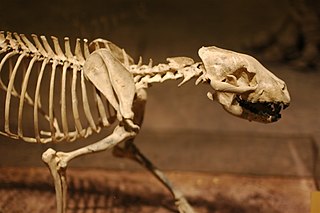
The extinct Borophaginae form one of three subfamilies found within the canid family. The other two canid subfamilies are the extinct Hesperocyoninae and extant Caninae. Borophaginae, called "bone-crushing dogs", were endemic to North America during the Oligocene to Pliocene and lived roughly 34—2.5 million years ago, existing for about 33.5 million years.

Phlaocyon is an extinct genus of the Borophaginae subfamily of canids native to North America. It lives from the Early Oligocene to the Early Miocene epoch 33.3–16.3 Mya, existing for approximately 17.3 million years. It is closely related to Cynarctoides.

Hesperocyon is an extinct genus of canids that was endemic to North America, ranging from southern Canada to Colorado. It appeared during the Uintan age, –Bridgerian age (NALMA) of the Mid-Eocene– 42.5 Ma to 31.0 Ma. (AEO). Hesperocyon existed for approximately 11.5 million years.

Cynodesmus is an extinct genus of omnivorous canine which inhabited North America during the Oligocene living from 33.3—-26.3 Ma and existed for approximately 7 million years.

Daphoenus is an extinct genus of amphicyonids. Daphoenus inhabited North America from the Late Eocene to the Middle Miocene, 37.2—16.0 Mya, existing for approximately 21 million years.

The John Day Formation is a series of rock strata exposed in the Picture Gorge district of the John Day River basin and elsewhere in north-central Oregon in the United States. The Picture Gorge exposure lies east of the Blue Mountain uplift, which cuts southwest–northeast through the Horse Heaven mining district northeast of Madras. Aside from the Picture Gorge district, which defines the type, the formation is visible on the surface in two other areas: another exposure is in the Warm Springs district west of the uplift, between it and the Cascade Range, and the third is along the south side of the Ochoco Mountains. All three exposures, consisting mainly of tuffaceous sediments and pyroclastic rock rich in silica, lie unconformably between the older rocks of the Clarno Formation below and Columbia River basalts above.

Caninae is the only living subfamily within Canidae, alongside the extinct Borophaginae and Hesperocyoninae. They first appeared in North America, during the Oligocene around 35 million years ago, subsequently spreading to Asia and elsewhere in the Old World at the end of the Miocene, some 7 million to 8 million years ago.
Parictis is an extinct arctoid belonging to the family Subparictidae.
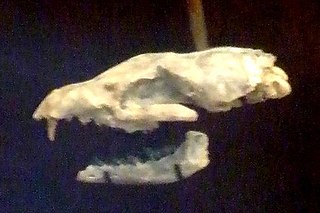
Archaeocyon is an extinct genus of the Borophaginae subfamily of canids native to North America. It lived during the Oligocene epoch 32-24 Ma., existing for approximately 8 million years. Species of Archaeocyon are among the earliest known borophagines, although a species of Otarocyon has a slightly earlier first appearance. Fossils have been found across the northern Great Plains and along the west coast of North America.
Nothocyon is an extinct genus of carnivoran in the family Subparictidae which inhabited North America during the late Oligocene. At one time, many species of the dog family Canidae were placed in Nothocyon, but new fossils showed that the type species of Nothocyon, N. geismarianus, is more closely related to bears. The other species have been reassigned to other genera such as Cormocyon.
Ectopocynus is an extinct genus of bone crushing canid which inhabited North America from the Oligocene to the Early Miocene. It lived from 33.3 to 16.0 Ma and existed for approximately 17.3 million years.
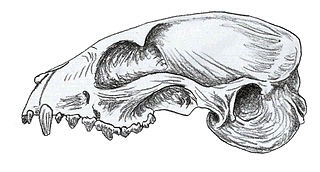
Otarocyon is an extinct genus of the Borophaginae subfamily of canids native to North America. It lived during the Oligocene epoch, about 33.3—20.6 Ma. Fossils have been found only in Montana, Wyoming, and South Dakota.

Miocyon is an extinct genus of placental mammals from clade Carnivoraformes, that lived in North America from the early to late Eocene.
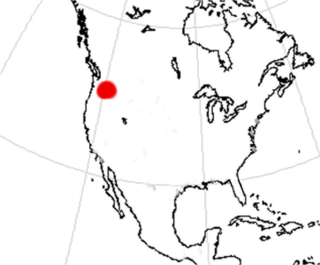
Rhizocyon is an early member of the subfamily Borophaginae, an extinct subgroup of canids that were endemic to western North America during the Oligocene epoch, living from ~31—24.5 Ma., existing for approximately 6.5 million years.
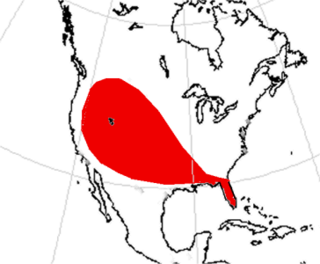
Phlaocyonini is an extinct clade or tribe of hypocarnivorous borophagines. They were endemic to North America and from the Oligocene epoch to the Miocene living ~33.3–5.3 Ma, existing for approximately 28 million years.

Borophagini is a clade or tribe of the subfamily Borophaginae. This is an extinct group of terrestrial canids that were endemic and widespread throughout North America and Central America which lived during the Geringian stage of the Oligocene epoch to the Zanclean age of the Early Pliocene living 30.8—3.6 Mya existing approximately 27.2 million years.

A hypocarnivore is an animal that consumes less than 30% meat for its diet, the majority of which consists of fungi, fruits, and other plant material. Examples of living hypocarnivores are the grizzly bear, black bear, binturong and kinkajou

Eucyon is an extinct genus of medium omnivorous coyote-like canid that first appeared in the Western United States during the late Middle Miocene 10 million years ago. It was the size of a jackal and weighed around 15kg. It was one of the few North American mammals which invaded Eurasia about 6 million years ago, followed by the genus going extinct 3 million years ago. This genus is proposed to have given rise to genus Canis 6 million years ago.
Phlaocyon latidens is an extinct species of the genus Phlaocyon, belonging to the subfamily Borophaginae and tribe Phlaocyonini, a canid which inhabited northwestern North America from the Late Oligocene to Miocene living 33.3–20.6 mya and existed for approximately 12.7 million years.















